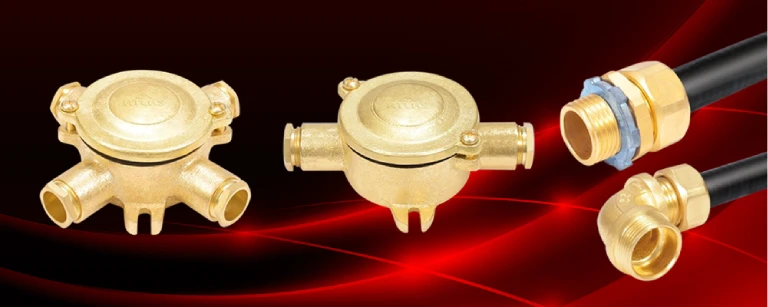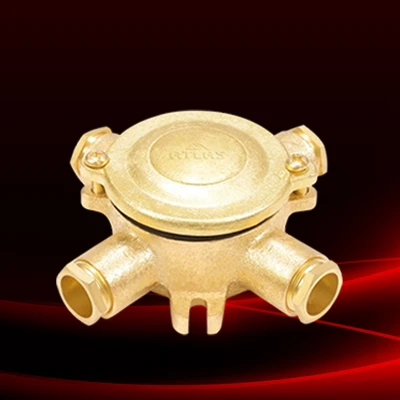|
Getting your Trinity Audio player ready...
|

Conduit fittings are a key part of any electrical installation system. They secure, protect, and guide wiring through walls, ceilings, and industrial structures. Choosing between flexible and rigid conduit fittings is not just about ease of use—it impacts safety, compliance, durability, and cost.
Whether you’re installing power lines indoors or running cables through outdoor environments, selecting the right conduits & fittings can make all the difference. This guide by Atlas Metal Industries, a trusted name in precision-engineered components, explores the differences between these two types and helps you make an informed decision.
Rigid conduit fittings are designed to work with non-flexible, straight-line conduit systems. These conduits are usually made from galvanized steel, aluminum, or rigid PVC.
Common rigid conduit fittings include:
- Threaded couplings
- Elbows
- Compression connectors
- Adapters
- Bushings
Pros of rigid conduit fittings:
- Excellent physical protection against impacts
- Weather-resistant (when using proper coatings)
- Maintains wire alignment over long distances
- Fewer entry points = fewer chances for leaks or damage
Cons:
- Requires bending tools for non-linear paths
- Heavier and more labor-intensive to install
- Not ideal in confined or complex routing spaces
Rigid conduits are ideal for structural settings that demand high durability and consistent protection, particularly in exposed, industrial, or commercial environments.
Flexible conduit fittings are designed for use with conduits that can bend or twist. These are made from materials like steel (FMC), plastic (ENT), or liquid-tight flexible metal (LFMC).
Common flexible conduit fittings include:
- Liquid-tight connectors
- Clamp or screw-on couplings
- Snap-in bushings
- Flexible elbows
Pros of flexible conduit fittings:
- Easier to install around corners or obstacles
- Suitable for vibrating equipment or machinery
- Lightweight and reduces labor time
- More cost-effective for complex layouts
Cons:
- Less mechanical protection compared to rigid types
- Can be more vulnerable to wear or moisture ingress
- May overheat if poorly ventilated or packed with high-voltage cables
Flexible metal conduit and outdoor flexible conduit variants offer better bendability and are particularly useful in applications requiring regular access, movement, or adjustments.
| Criteria | Rigid Conduit Fittings | Flexible Conduit Fittings |
|---|---|---|
| Material | Steel, Aluminum, PVC | FMC, LFMC, ENT |
| Flexibility | Low | High |
| Protection Level | High | Moderate |
| Installation Complexity | More complex | Easier and faster |
| Cost | Higher | Lower |
| Ideal Use Case | Outdoor, structural setups | Indoor, machinery, confined areas |
| Common Location | Industrial zones, basements | Kitchens, workshops, movable units |
This side-by-side comparison clarifies the practical differences between rigid conduit and flexible conduit fittings to help you assess based on need.
Before making a selection, evaluate the specific needs of your application:
- Environment: Use outdoor flexible conduit or rigid conduit with waterproof coatings in moist or corrosive conditions.
- Load Exposure: Rigid types offer better mechanical strength in high-impact zones.
- Ease of Installation: Flexible conduits reduce time and material waste in curved or tight spaces.
- Compliance: Always refer to NEC or IEC guidelines on grounding and sealing.
- System Movement: For vibrating or movable systems, flexible options are ideal.
Atlas Metal Industries emphasizes aligning conduit selection with both environmental and regulatory factors for best performance.
Proper installation ensures safety and system longevity. Here are some universal tips:
- Use only compatible conduits & fittings for each conduit type.
- Ensure cut conduit edges are smooth to prevent wire damage.
- Always tighten connections to NEC torque specifications.
- Apply sealing washers or tapes in outdoor flexible conduit installations.
- Use straps and hangers to relieve strain and prevent sagging or disconnection.
These best practices apply equally to both flexible metal conduit and rigid conduit fittings, especially in industrial and commercial environments.
Understanding the differences between flexible and rigid conduit fittings is essential for planning safe and effective wiring systems. While rigid fittings provide unmatched protection and durability, flexible options excel in adaptability and ease of use.
Evaluate based on your environment, safety codes, and layout needs. And when in doubt, consult a certified installer or an expert at Atlas Metal Industries—a brand known for quality and innovation in conduits & fittings.
Flexible fittings are designed for conduits that bend, while rigid fittings suit straight-line, high-protection installations.
Flexible conduit fittings are ideal for tight spaces, areas with movement, or environments that require frequent changes.
Yes, but only if using rated outdoor flexible conduit with appropriate weatherproof fittings.
Yes, due to their uniform structure, rigid conduit fittings are often easier to align and clamp in long runs.
Use compression or liquid-tight connectors and confirm installation meets NEC/IEC sealing requirements.

